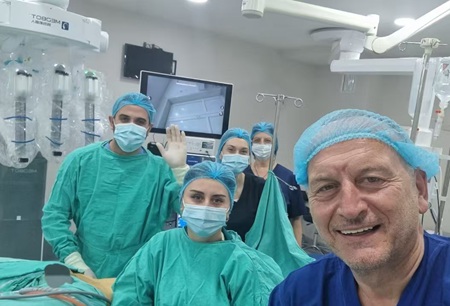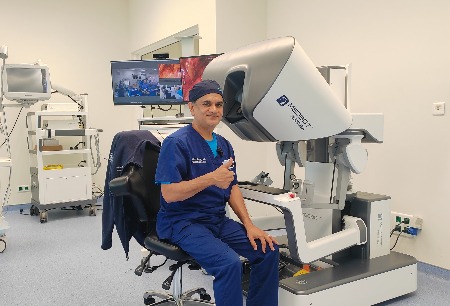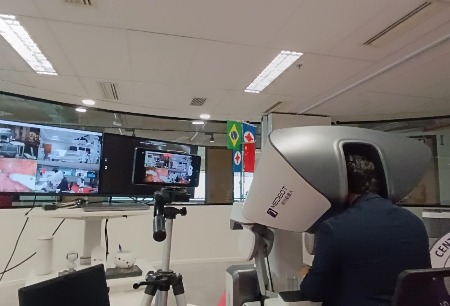Recently, with the assistance of the Toumai® Surgical Robot, 10 cases of highly difficult 5G remote urologic surgeries were completed successfully by the team of Prof. Dan Xia and Prof. Shuo Wang from the Urology Department of the First Affiliated Hospital of Zhejiang University School of Medicine (referred to as “FAHZU”), as the operator, and together with the team of Prof. Zhiyang Huang from the Quanzhou First Hospital Affiliated to Fujian Medical University (referred to as “QZFAH”), as the on-site assistant. All cases were proven by rigorous and sufficient technical justification, animal experiment and the scientific ethics justification.
These 10 cases were facing extreme challenges, most of which were difficult Level 4 urologic surgeries, covering three-consecutive surgeries of radical prostatectomy, radical nephrectomy for renal tumor, radical cystectomy, and partial nephrectomy. What’s worse, the conditions of the patients were riddled with “dubious or hard-to-treat cases”: huge prostate up to 100 g, giant spherical renal tumor with a diameter of 9 cm, time-consuming and complicated total cystectomy, abnormal renal arteries, etc.; even those regular local robotic surgeries as challenging as these ones are facing high difficulty and risk, not to mention the current 5G remote surgeries by using robots, which would encounter tougher challenges, and place rigorous requirements on the 5G signal transmission and the performance of the surgical robot, that no delay or stuck is allowed, while the device motion need to be accurate with stable operation.
The total success of these 10 cases of highly difficult 5G remote urologic surgeries not only benefits the local patients, but also creates many world records for the 5G remote robotic urologic surgeries. It verifies that Toumai® robot 5G remote surgery can handle the challenges of high difficulty, high complexity, and continuity in minimally invasive surgery, laying a solid foundation for the regular conduction of 5G remote robot minimally invasive urologic surgery in the future.
6 Cases of 5G Remote Radical Prostatectomy
A Record of the World’s First Case and the World’s First-of-Its-Kind Three-Consecutive Surgeries
On July 4th, with the assistance of the Toumai® robot, the world’s first 5G remote robot-assisted laparoscopic radical prostatectomy (RALRP) was completed successfully by the surgical team led by Prof. Dan Xia, Director of Urology Department, and Prof. Shuo Wang from FAHZU, who closely cooperated with Prof. Zhiyang Huang’s team at QZFAH. It signified the cooperation kick-off of the two hospitals for Toumai® robot-assisted 5G remote surgery.
On July 20th, Toumai® robot completed the three-consecutive surgeries of 5G remote radical prostatectomy on the same day, which again breaks a world record and fully verifies the true power of Toumai® robot in performing 5G remote surgery. All 3 cases were male elderlies. Prof. Shuo Wang and Prof. Dan Xia leveraged their superb skills to accurately dissociate vessels and nerves of the patients. With the help of Toumai® robot, they peeled off layer by layer the surrounding tissue of the prostate, freeing and dissecting the giant prostate gland, and completed the excision. On August 5th, Toumai® robot once again completed successfully 2 cases of 5G remote radical prostatectomy. In just a month, the total success of 6 cases of highly difficult 5G remote surgical robot-assisted radical prostatectomy has laid a solid foundation for the regular conduction of 5G remote robot minimally invasive urologic surgery in the future.
Director Dan Xia said that the robot-assisted radical prostatectomy is one of the difficult urologic surgeries, which requires precise control of the robot’s wrist in an extremely narrow space of the abdominal cavity to complete time-consuming pulling, dissociation, and cutting, and often requires extensive lymph node dissection. Compared to open surgery, laparoscopic robot is significantly advantageous in minimal invasiveness, precision, flexibility, and anti-jittering, thus better realizing surgical expectations.
The total success of these 6 cases of 5G remote robot-assisted radical prostatectomy not only represents a whole new milestone set by FAHZU in the field of 5G remote surgery in China, but also marks the increasingly mature application of Toumai® robot in 5G remote urologic surgery.
The World’s First 5G Remote Radical Cystectomy
Risky, Complex and Challenging
On July 8th, the world’s first 5G remote four-arm robot assisted radical cystectomy + bilateral pelvic lymphadenectomy + Bricker ileal conduit surgery was completed successfully.
The patient was a 69-year-old male, who has repeatedly suffered from hematuria, frequent micturition, urgent micturition and painful micturition for 1 year. He was sent to QZFAH, with diagnostic TURS pathology revealed: bladder cancer (high-grade papillary urothelial carcinoma). The medical teams from both locations reviewed and analyzed the comprehensive pathological conditions of the patient and came up with rigorous and cautious individualized treatment plan, where Toumai® robot assisted radical cystectomy + Bricker ileal conduit surgery + bilateral pelvic lymphadenectomy was proposed.
Empowered by the China Telecom 5G networking signal, Prof. Shuo Wang who was located at the intelligent training center of FAHZU, via Toumai® robot console, sent commands to the robotic arms of the Toumai® robot that was located in the operating room of QZFAH. He operated four robotic arms to gradually sneak through the patient’s lower abdominal cavity, and ultimately completed the dissection and resection of bladder and prostate with a success. The whole surgery took a total of 4 hours and 18 minutes, and the bleeding volume was only 100 ml.
After surgery, Prof. Shuo Wang commented the case that the radical cystectomy + bilateral pelvic lymphadenectomy + Bricker ileal conduit surgery was a Level 4 surgery that was risky, complex, and challenging. The surgical cleaning involved wider range, where there were abundant vessels, nerves, as well as important organs such as the intestine and bladder, which needed to be reconstructed. Also, this was a remote surgery that posed rigorous requirements on the 5G signals as well as the performance of the surgical robot – no delay or latency was allowed, and device motion must be precise with stable operation. This successful minimally invasive surgery assisted by the China-made Toumai® robot was of great benefit to the postoperative recovery and reduced complications for the patients.
5G Remote Adrenalectomy
Lesion Removed Successfully for a Patient Weighted Almost 100 Kg
On July 8th, Prof. Shuo Wang led the team to complete a highly difficult case of 5G remote adrenalectomy. The patient was a 69-year-old male, 95 Kg in weight, 168 cm in height, and BMI 33.6. The thick fatty tissue wrapped the kidneys and adrenal glands tight. Obesity made the supposedly simple operation even harder.
With the high-definition 3D FOV provided by Toumai® robot, Prof. Shuo Wang was able to switch his left and right hand swiftly, controlling Toumai® robotic arm to gradually explore and dissociate, removing adrenal tumor tissue for the patient.
5G Remote Radical Nephrectomy for Renal Tumor
The Tumor Gravely Invades the Adipose Tissue of the Kidney, Which Need to be Dissected Piece by Piece
On July 9th, Prof. Dan Xia led the team to complete successfully a 5G remote radical nephrectomy for renal tumor. The patient was a 56-year-old male with clinical diagnosis of left renal cancer. With the HD FOV provided by Toumai® robot and the assistance of the precision device, Prof. Dan Xia controlled the robotic arm to dissociate and dissect the entire kidney within the narrow retroperitoneum. During the surgery, it was found that the renal structure invaded by the tumor almost occupied the entire operating space, making it almost impossible to complete the surgery. However, with the precise assistance of Toumai® robot, the surgery was completed successfully in 3 hours and 50 minutes, which could even be regarded as a model of surgical operation, bringing new life for the patient.
5G Remote Partial Nephrectomy
Peeling Off a Giant Spherical Renal Tumor in 9 cm Diameter
On August 5th, Prof. Dan Xia led the team to complete a case of partial nephrectomy. The patient was a 52-year-old male, with diagnosis showed: left kidney tumor, approximately 9cm*9cm. Preoperative examination revealed a space-occupying lesion of the left kidney and abnormal perirenal vessels.
The massive tumor invasion caused physical pain to the patient, with symptoms such as hematuria and abdominal lumps. The quality of life was adversely affected. By using the agile and stable robotic arms of the Toumai® robot, Prof. Dan Xia prioritized to separate the deformed and complex arteriovenous vessels and complete blockage; she further dissected and removed the 9cm diameter tumor embedded in the kidney. The surgery took 3 hours and 26 minutes in total.
As per Mr. Yu Liu, Executive Vice President and Chief Commercial Officer of the MicroPort® MedBot®:
He is very grateful of the support to Toumai® robot by FAHZU and QZFAH. With the close cooperation in between Prof. Dan Xia and Prof. Shuo Wang from FAHZU and Prof. Zhiyang Huang from QZFAH, Toumai® robot is capable of completing 10 cases of highly difficult 5G remote urologic surgeries in 5 surgical days, indicating that the 5G technology and system stability of Toumai® robot may satisfy the needs of conducting complex, time-consuming, and difficult minimally invasive urologic surgeries on a regular basis. We believe that, with the joint cooperation of MicroPort® MedBot® and clinical experts, the continuous exploration of 5G remote robotic surgery is destined to create greater value for the healthcare services and the patient needs, thus achieving our intention “to get rid of difficult surgeries in the world”.
-
 2024-11-18Karazanashvili Robotic Center Completed 100 Toumai® Robot-Assisted Surgeries, becoming the Only Robotic Surgery Center in the Caucasus Region
2024-11-18Karazanashvili Robotic Center Completed 100 Toumai® Robot-Assisted Surgeries, becoming the Only Robotic Surgery Center in the Caucasus Region -
 2024-10-26TOUMAI® SURGICAL ROBOT SYSTEM COMPLETES MULTIPLE LANDMARK ROBOTIC TELESURGERY CASES IN SUB-SAHARA AFRICA IN THE REPUBLIC OF ANGOLA
2024-10-26TOUMAI® SURGICAL ROBOT SYSTEM COMPLETES MULTIPLE LANDMARK ROBOTIC TELESURGERY CASES IN SUB-SAHARA AFRICA IN THE REPUBLIC OF ANGOLA -
 2024-10-26Toumai® Achieves South America's First Tele-Surgery Demonstration
2024-10-26Toumai® Achieves South America's First Tele-Surgery Demonstration






 Hu ICP Bei No. 20013662 HGWA Bei No. 31011502015178
Hu ICP Bei No. 20013662 HGWA Bei No. 31011502015178 " are registered trademarks of Shanghai MicroPort Medical (Group) Co., Ltd.” . They have been authorized to be used by Shanghai Microport Medbot (Group) Co., Ltd., and no other party shall use such trademarks without prior written permission thereof.
" are registered trademarks of Shanghai MicroPort Medical (Group) Co., Ltd.” . They have been authorized to be used by Shanghai Microport Medbot (Group) Co., Ltd., and no other party shall use such trademarks without prior written permission thereof.
